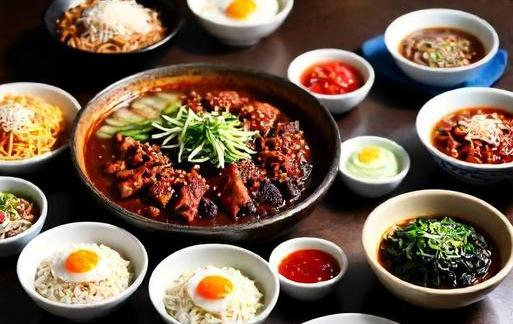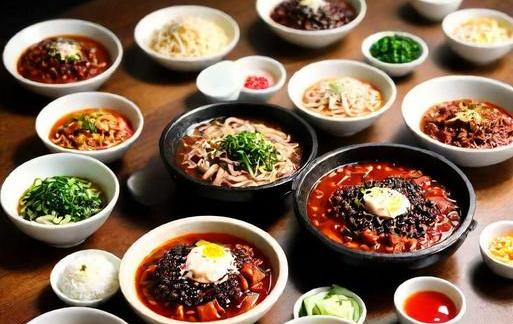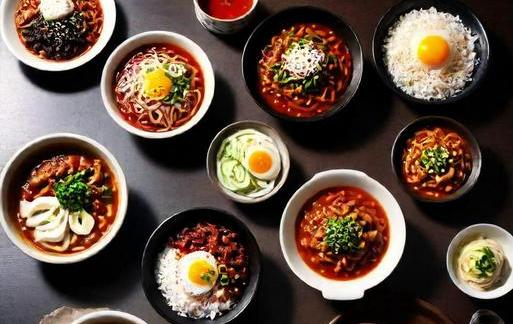- You are here:
- Home »
- Food
- » [REVEALED] Korean Foods That Start With B
[REVEALED] Korean Foods That Start With B
Note: This page contains affiliate links.
As an Amazon Associate, I earn from qualifying purchases when you click on the link, but you are not charged extra.
Korean cuisine is renowned for its rich flavors, unique cooking techniques, and diverse range of dishes. In this culinary journey, we delve into the world of Korean foods that start with the letter ‘B’. From savory to sweet, traditional to modern, the Korean culinary landscape offers a tantalizing array of options. Join us as we explore the nuances of each dish, uncovering the cultural significance and the meticulous preparation that goes into crafting these delectable treats.
Contents
- 1 List Of Korean Foods That Start With B
- 1.1 1. Bibimbap (비빔밥): A Harmony Of Colors And Flavors
- 1.2 2. Bossam (보쌈): A Porky Delight For Gatherings
- 1.3 3. Banchan (반찬): Small Bites, Big Flavors
- 1.4 4. Bindaetteok (빈대떡): Crispy Mung Bean Pancakes
- 1.5 5. Bokkeum (볶음): The Art Of Stir-Frying
- 1.6 6. Baek Kimchi (백김치): White Kimchi For A Mild Palette
- 1.7 7. Bungeoppang (붕어빵): Fish-Shaped Delights
- 1.8 8. Baechu Kimchi (배추김치): The Staple Fermented Cabbage
- 1.9 9. Bibim Guksu (비빔국수): Spicy Mixed Noodles
- 1.10 10. Budae Jjigae (부대찌개): Army Base Stew With A Historical Twist
- 2 Significance
- 3 Category-Related
- 4 Common Themes
- 5 Interesting Facts
- 6 Conclusion
List Of Korean Foods That Start With B

1. Bibimbap (비빔밥): A Harmony Of Colors And Flavors
Bibimbap, meaning "mixed rice," is a quintessential Korean dish that exemplifies balance and harmony. A vibrant medley of rice, sautéed vegetables, gochujang (Korean red pepper paste), a fried egg, and thinly sliced beef, bibimbap is art on a plate. The dish is meticulously arranged, with each ingredient placed in its own section, creating a visually appealing masterpiece. The marriage of textures and flavors, from the crispiness of the rice crust to the tenderness of the beef, makes bibimbap a beloved dish both in Korea and internationally.
2. Bossam (보쌈): A Porky Delight For Gatherings
Bossam, a traditional Korean dish, revolves around the concept of wrapping. Thin slices of boiled pork belly are served with a variety of condiments such as garlic, ssamjang (a thick, spicy paste), and pickled radishes. The diners take a piece of pork, add their desired accompaniments, and wrap it in a leafy green, typically napa cabbage or lettuce. This communal and interactive dining experience is popular during festive occasions and gatherings, making bossam a go-to dish for celebratory feasts.
3. Banchan (반찬): Small Bites, Big Flavors
Banchan refers to the assortment of small side dishes served alongside cooked rice in Korean cuisine. While not a single dish per se, the concept of banchan embodies the essence of communal dining. These side dishes vary widely, ranging from kimchi (fermented vegetables) to namul (seasoned and sautéed vegetables), providing a diverse array of flavors and textures to complement the main course. Banchan showcases the meticulous attention to detail in Korean culinary traditions, offering a sensory journey with every bite.
4. Bindaetteok (빈대떡): Crispy Mung Bean Pancakes
Bindaetteok, or mung bean pancakes, are a beloved street food in Korea. These pancakes are made by grinding soaked mung beans into a batter, mixed with vegetables such as kimchi, onions, and leeks. The mixture is then pan-fried to golden perfection, resulting in a crispy exterior and a soft, savory interior. Bindaetteok is often enjoyed with a dipping sauce made of soy sauce, vinegar, and sesame oil. The contrasting textures and the savory flavor profile make bindaetteok a delightful snack or appetizer.
5. Bokkeum (볶음): The Art Of Stir-Frying
Bokkeum is a cooking technique in Korean cuisine that involves stir-frying various ingredients with seasonings. While not a specific dish, the term "bokkeum" encompasses a wide range of stir-fried dishes, each highlighting the flavors of the main ingredient. For instance, kimchi bokkeum involves stir-frying kimchi with pork or tofu, creating a spicy and savory dish. The versatility of bokkeum allows for endless creativity in the kitchen, making it a staple in Korean households.
6. Baek Kimchi (백김치): White Kimchi For A Mild Palette
Baek kimchi, or white kimchi, is a milder and less spicy version of the more well-known red kimchi. Unlike its fiery counterpart, baek kimchi is prepared without gochugaru (red chili flakes), resulting in a cleaner and subtler flavor profile. This variety of kimchi often includes ingredients such as napa cabbage, daikon radish, and pear, creating a refreshing and slightly sweet taste. Baek kimchi is a preferred choice for those who enjoy the complexity of kimchi without the intense heat.
7. Bungeoppang (붕어빵): Fish-Shaped Delights
Bungeoppang, literally translated as "carp bread," is a popular Korean street food known for its unique fish-shaped appearance. These pastry treats are made by pouring a sweet batter into a fish-shaped mold and filling it with various sweet fillings such as red bean paste, custard, or chocolate. The result is a crispy, golden-brown exterior that gives way to a delightful burst of sweetness with each bite. Bungeoppang is not only a delicious snack but also a nostalgic treat for many Koreans, reminiscent of childhood days spent at bustling street markets.
8. Baechu Kimchi (배추김치): The Staple Fermented Cabbage
Baechu kimchi, or cabbage kimchi, is perhaps the most iconic and widely consumed type of kimchi in Korea. This fermented dish is made by salting and seasoning napa cabbage, radishes, and other vegetables, before allowing them to ferment. The result is a tangy, spicy, and pungent dish that is not only a side dish but also a key ingredient in many Korean recipes. The meticulous process of preparing baechu kimchi reflects the deep-rooted cultural importance of fermentation in Korean cuisine.
9. Bibim Guksu (비빔국수): Spicy Mixed Noodles
Bibim guksu is a cold noodle dish that packs a punch of flavors and heat. The dish features thin wheat noodles tossed with a spicy gochujang-based sauce, vegetables, and sometimes a protein such as beef or boiled eggs. Bibim guksu is a popular choice during the hot summer months, offering a refreshing and spicy kick that stimulates the taste buds. The combination of chewy noodles and the zesty sauce makes bibim guksu a favorite for those craving a satisfying yet cooling meal.
10. Budae Jjigae (부대찌개): Army Base Stew With A Historical Twist
Budae jjigae, also known as army base stew, has a unique history rooted in post-war Korea. Created using surplus military rations from U.S. army bases, this stew combines an assortment of ingredients such as spam, hot dogs, instant noodles, kimchi, and various vegetables. The result is a flavorful and hearty stew that reflects the resilience and adaptability of the Korean people during challenging times. Budae jjigae has evolved into a beloved comfort food, enjoyed by many for its eclectic mix of ingredients and bold flavors.
Korean cuisine never fails to captivate the senses, and the diverse array of foods that start with the letter ‘B’ is a testament to its richness and complexity. From the iconic bibimbap to the innovative budae jjigae, each dish carries a unique story, reflecting the cultural heritage and culinary ingenuity of Korea. Whether you’re exploring the bustling street markets or enjoying a meal with family and friends, these Korean delights starting with ‘B’ promise a gastronomic adventure filled with flavors, textures, and a deep connection to tradition. So, the next time you find yourself craving a taste of Korea, consider delving into the world of bibimbap, bossam, banchan, and the myriad of other ‘B’ delights that await your palate.
Significance

Korean cuisine is renowned for its rich flavors, diverse ingredients, and unique culinary traditions. Among the myriad of Korean dishes, those starting with the letter "B" hold a special place. In this comprehensive exploration, we will delve into a variety of Korean foods that start with the letter "B," uncovering the cultural significance, common themes, and interesting facts surrounding these delectable dishes.
Understanding the significance of Korean foods that start with "B" requires a glimpse into the cultural tapestry of Korea. Korean cuisine is deeply rooted in a combination of historical influences, geographical features, and agricultural abundance. The country’s emphasis on balance, texture, and bold flavors has given rise to a plethora of dishes that tantalize the taste buds.
Foods starting with "B" in Korean cuisine are not only a testament to the culinary diversity but also reflect the meticulous preparation methods and attention to detail that characterize Korean cooking. These dishes often hold cultural, familial, and social importance, becoming integral parts of celebrations, gatherings, and daily meals.
Category-Related

Bibimbap: The Artful Mix
One of the most iconic Korean dishes, Bibimbap, takes the spotlight in the "B" category. This delectable dish features a colorful array of vegetables, marinated meat (usually beef), a fried egg, and a dollop of spicy gochujang (red chili paste), all served on a bed of steamed rice. The beauty of Bibimbap lies in its presentation – the ingredients are meticulously arranged in a vibrant display, inviting diners to mix them together just before indulging in a burst of flavors and textures.
Banchan: Small Bites, Big Impact
Banchan refers to an assortment of small side dishes served alongside rice in Korean meals. While the specific banchan can vary, the emphasis on balance and variety is a constant. From kimchi (fermented vegetables, usually cabbage or radishes) to namul (seasoned vegetables), banchan provides a diverse array of tastes, textures, and nutritional elements. The communal aspect of sharing banchan further enhances the dining experience, making it a staple in Korean households.
Bossam: Wrapped Delight
Bossam, a savory dish with a delightful wrapping ritual, involves boiled pork belly slices served with a variety of accompaniments. The key to the bossam experience lies in wrapping a slice of pork in a leafy green, typically napa cabbage or perilla leaves, and adding a touch of ssamjang (a thick, spicy paste). The resulting bite-sized package offers a harmonious blend of flavors – the richness of pork, the freshness of greens, and the kick of ssamjang.
Budae Jjigae: Fusion Stew
Budae Jjigae, often referred to as army stew, is a fusion creation born out of historical circumstances. Following the Korean War, surplus processed foods from U.S. military bases found their way into local markets. Budae Jjigae incorporates ingredients like Spam, hot dogs, instant noodles, and kimchi into a spicy stew base, creating a unique blend of American and Korean flavors. This dish not only reflects the adaptive nature of Korean cuisine but also carries historical significance, symbolizing resilience and resourcefulness during challenging times.
Common Themes
Bold Flavors And Balanced Tastes
Korean foods that start with "B" share a common thread of bold flavors and a commitment to achieving a balance of tastes. Whether it’s the spicy kick of gochujang in Bibimbap or the umami explosion in Budae Jjigae, these dishes prioritize the harmonious interplay of sweet, salty, spicy, and savory notes. This dedication to balance is a fundamental aspect of Korean culinary philosophy, creating a symphony of flavors that dance on the palate.
Cultural Connection Through Communal Dining
Another recurring theme is the cultural significance of communal dining. Whether it’s the shared experience of mixing Bibimbap at the table or passing around banchan dishes, Korean "B" foods emphasize the communal nature of Korean meals. Dining in Korea is often a social event, bringing people together to share not only food but also conversation, laughter, and a sense of togetherness.
Versatility In Ingredients And Preparation
The versatility of ingredients and preparation methods is evident in Korean "B" foods. From the diverse array of vegetables used in Bibimbap to the unconventional mix of processed and traditional ingredients in Budae Jjigae, Korean cuisine showcases an adaptability that reflects the country’s historical encounters and openness to new culinary influences. This flexibility in ingredients and techniques contributes to the dynamic and ever-evolving nature of Korean gastronomy.
Interesting Facts
Banchan Variability
One fascinating aspect of Korean banchan is the incredible variability from one meal to another. The number and types of banchan served can vary widely, ranging from three to a dozen or more. This variability not only keeps meals exciting but also allows chefs and home cooks to showcase seasonal ingredients and regional specialties.
Bibimbap’s Symbolic Representation
Bibimbap, with its visually stunning presentation and symbolic significance, goes beyond being just a delicious dish. The colorful arrangement of ingredients in Bibimbap is said to represent the five elements of traditional Korean cosmology: wood, fire, earth, metal, and water. The act of mixing these elements before eating is believed to bring about balance and harmony in life.
Bossam’s Historic Roots
The roots of Bossam trace back to the Joseon Dynasty, where it was initially served in royal courts. The dish has evolved over the centuries, transitioning from a noble delicacy to a beloved comfort food enjoyed by people from all walks of life. This historical journey adds an extra layer of depth to the experience of savoring bossam.
Budae Jjigae And Culinary Adaptation
Budae Jjigae’s emergence as a fusion stew reflects Korea’s ability to adapt and innovate in response to historical challenges. The dish’s incorporation of processed foods from military rations is a testament to the resilience of the Korean people during times of scarcity. Today, Budae Jjigae stands as a symbol of creativity and adaptability in the face of adversity.
Conclusion
In conclusion, exploring Korean foods that start with "B" unveils a captivating world of culinary delights deeply rooted in cultural significance, communal traditions, and adaptability. From the artful mix of Bibimbap to the communal joy of sharing banchan, and the historic roots of Bossam to the innovative fusion of Budae Jjigae, each dish tells a unique story within the broader narrative of Korean cuisine.
These foods not only showcase the mastery of flavor combinations but also embody the spirit of Korean gastronomy – a celebration of diversity, resilience, and the joy of shared meals. As we continue to delve into the intricacies of Korean culinary traditions, the "B" foods stand as vibrant representatives of a culture that embraces both its rich history and the ever-evolving nature of its cuisine.


